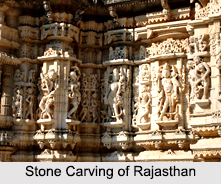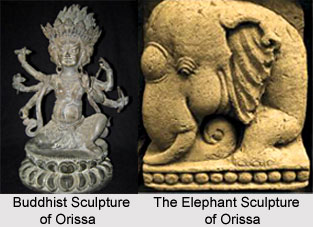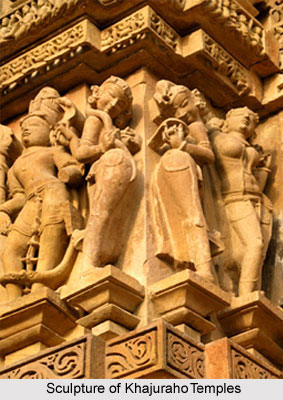 Temple sculpture of Rajasthan are found in the temples of ancient and medieval times in Bharatpur, Abaneri, Baroli, Ramgarh, Nagda, Ajmer, Chittor, Mandore, Osiytan, Jaisalmer, Bikaner, and Udaipur. Rajput architecture and sculpture have also been fused in these temple walls. It was not before the 8th century that the temple sculpture of Rajasthan flourished. The Rajput kings use to practised religious tolerance. As a result a number of Jain temples are simultaneously found with the Hindu temples.
Temple sculpture of Rajasthan are found in the temples of ancient and medieval times in Bharatpur, Abaneri, Baroli, Ramgarh, Nagda, Ajmer, Chittor, Mandore, Osiytan, Jaisalmer, Bikaner, and Udaipur. Rajput architecture and sculpture have also been fused in these temple walls. It was not before the 8th century that the temple sculpture of Rajasthan flourished. The Rajput kings use to practised religious tolerance. As a result a number of Jain temples are simultaneously found with the Hindu temples.
Features of Temple sculpture of Rajasthan
Rajasthan is famous for its magnificent architectural monuments made of stone. Forts, palaces and Temples are amazing success of the craftsmen that have few competitors.
The features of Rajput sculptures have been greatly influenced by the Mughal sculptures and architectures.
 Stone art and sandstone art are very important art forms that develop noise in Rajasthan. The forts, palaces and stunning havelis of Rajasthan are all big examples of the amazing stone work of the state. The bright stone-carving or delicate jali work in stone of this region is very characteristic. Jaipur, Jodhpur, Jaisalmer, Thanagazi, Kishori Makrana, and Dungarpur are the foremost centres. Well decorated domestic wares in stone are fantastically planned with lot of concentration to the sculpture and its style. An amazing example is the statue of the Sun God.
Stone art and sandstone art are very important art forms that develop noise in Rajasthan. The forts, palaces and stunning havelis of Rajasthan are all big examples of the amazing stone work of the state. The bright stone-carving or delicate jali work in stone of this region is very characteristic. Jaipur, Jodhpur, Jaisalmer, Thanagazi, Kishori Makrana, and Dungarpur are the foremost centres. Well decorated domestic wares in stone are fantastically planned with lot of concentration to the sculpture and its style. An amazing example is the statue of the Sun God.
Sculptural temple works of Rajasthan
The common Jain temples have vast sculptures of their tirthankaras preserved in the chamber. The stone is sculpted, carved, concaved out and then built up so that each grain turns into an element of the impressive design of the shrine. The pillars are carved in an altered way so that each pillar is different. The most brilliant examples of Jain temples in Rajasthan are at Ranakpur and at Mount Abu. Ranakpur consists of a fortified complex of temples that arise in Mewar. At the heart of the complex there is the temple of Adinath, one of the largest, most extensive and characterised by excess and profusion of sculpture. The 144 pillars are sculptured with arabesques, motifs and statues carved almost in the round. In the centre there is a sanctum with the four-faced image.
People of Rajasthan possess the art of switching the normal clay into amazing Sculptures. The artists used the transcriptions of Manasara and Shilpashastra as their instructions for producing the fascinated sculptures out of regular clay. Jaipur is famous for the marble images that can be best observed in the famous Dilwara temples. The sculpture of Dilwara Jain Temple is famous for its elaborate details.
A row of figures embellishes the Surya temple, situated in Jhalarapatan, southern Rajasthan. The stone carvers of this region produced some of the finest temples dedicated to Devi, Shiva, Vishnu, and the Sun God, adorning the buildings with delicately carved figures of human and celestial beings. Elephants also formed a part of a sculptured panel from a Jain temple, Sat Bis Deorhi, in Chittorgarh. Hindu and Jain temples, Victory towers and palace coexist within the sprawling fort of Chittorgarh.
Various panels within the temple display figures of men, women and animals in high relief. The majestic figures of elephants are found almost everywhere. Jain temples are infused with sculptures. The stone is moulded, chiselled, scooped out and then developed. This way each grain becomes a part of the grand design of the temple.



















